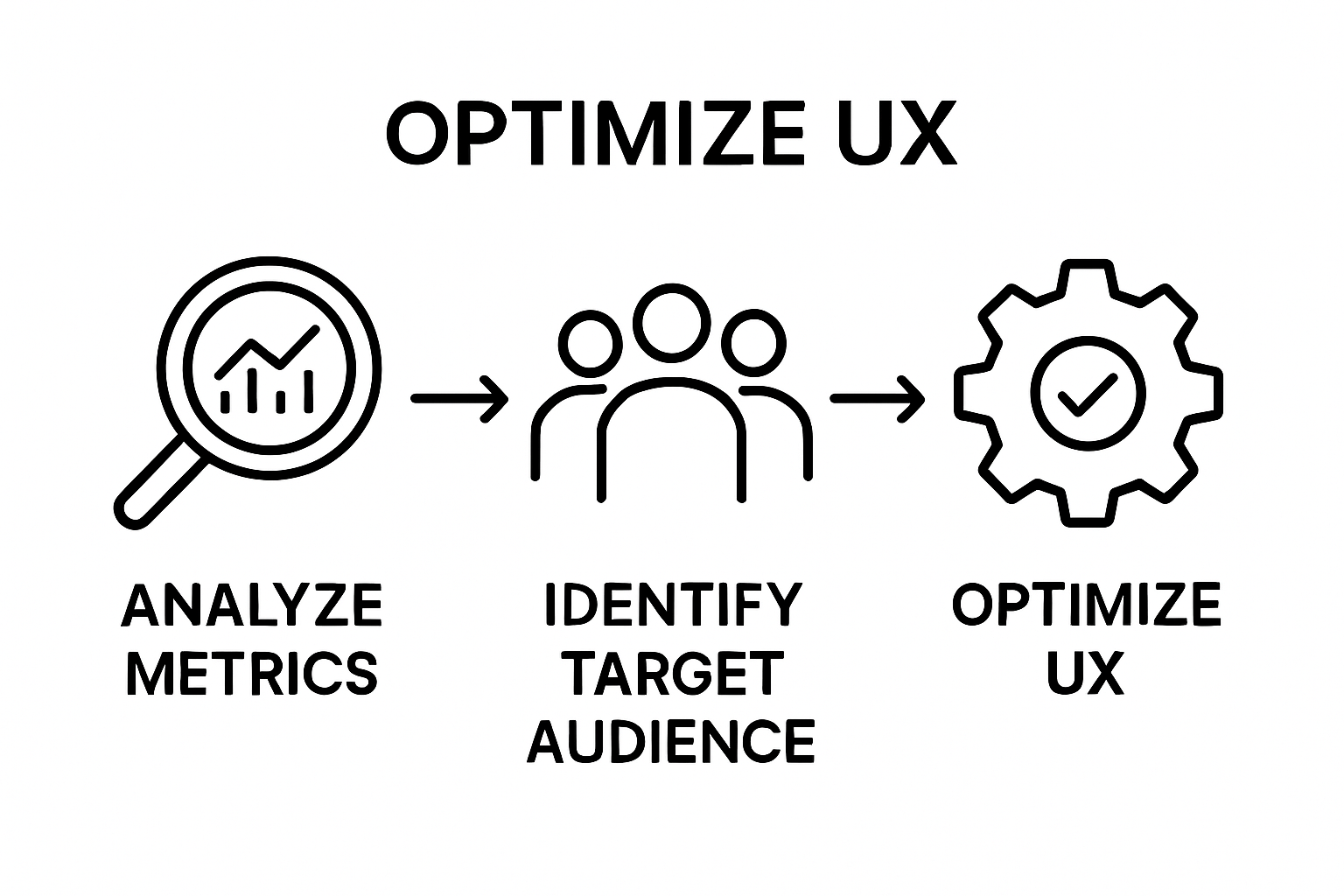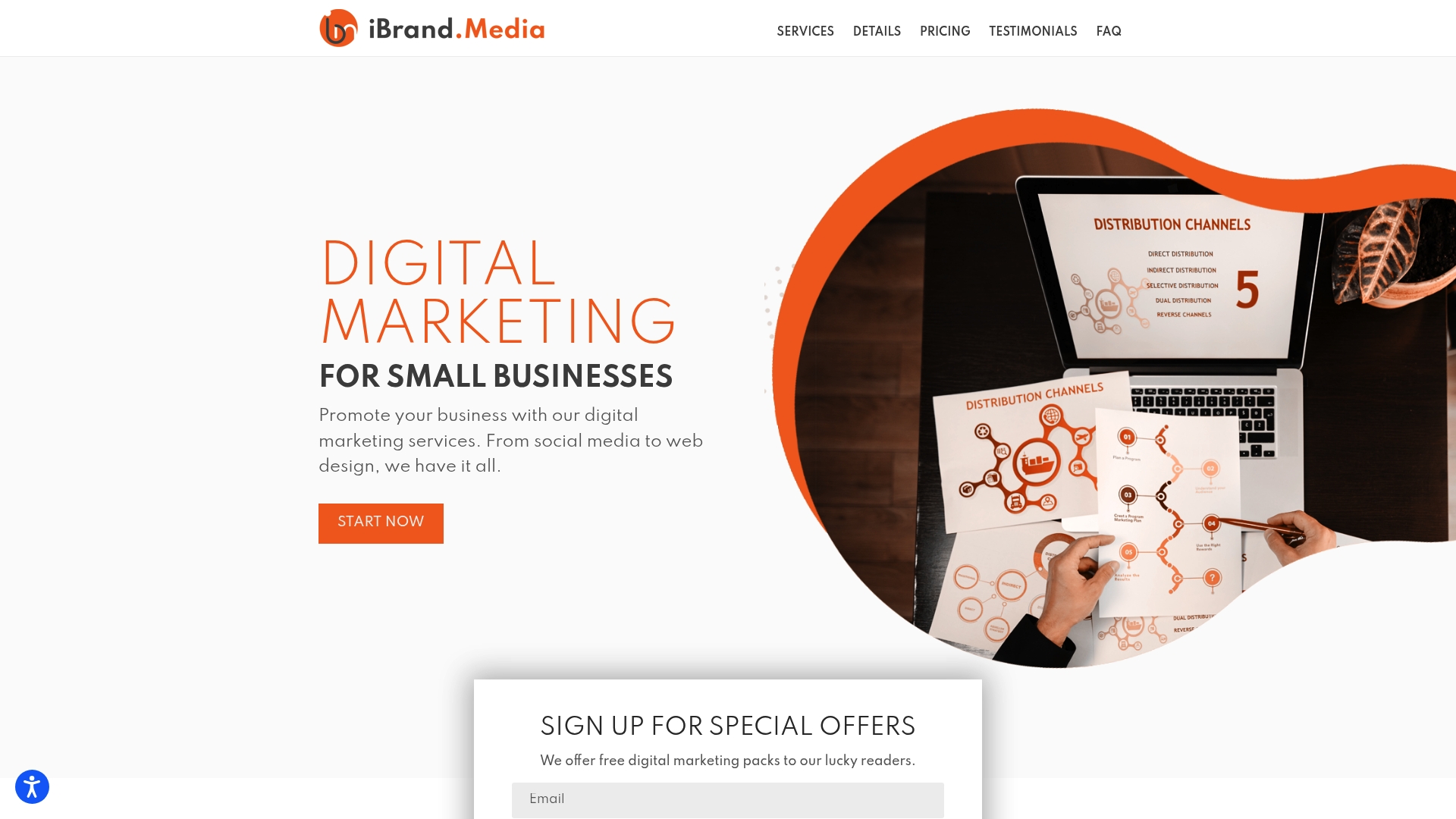Website traffic means nothing if visitors leave before taking action. Did you know that pages with high traffic but low conversions expose your biggest missed opportunities? Most site owners only check surface stats and miss the moments where users hesitate, click away, or get lost. It turns out, unlocking real growth starts with reading both the numbers and the human behavior behind them.
Table of Contents
- Step 1: Analyze Your Current Conversion Metrics
- Step 2: Identify Target Audience And Their Needs
- Step 3: Optimize Your Website’s User Experience
- Step 4: Craft Compelling Calls To Action
- Step 5: Utilize A/B Testing For Continuous Improvement
- Step 6: Monitor Results And Adjust Strategies Accordingly
Quick Summary
| Key Point | Explanation |
|---|---|
| 1. Analyze Current Conversion Metrics | Gather data from platforms like Google Analytics to assess existing conversion rates and identify areas for optimization. |
| 2. Define Target Audience Profiles | Create detailed audience personas, including motivations and challenges, to tailor marketing efforts effectively. |
| 3. Improve User Experience | Conduct audits to optimize website usability, focusing on fast load speeds and intuitive navigation for users. |
| 4. Create Compelling Calls to Action | Use clear, action-oriented language and strategic design for CTAs to enhance user engagement and drive conversions. |
| 5. Implement A/B Testing Regularly | Test different website elements systematically to identify what drives the highest conversion rates and improve continuously. |
Step 1: Analyze Your Current Conversion Metrics
Decoding your website’s performance begins with a meticulous examination of conversion metrics. This critical first step transforms raw data into actionable insights that will dramatically improve your online strategy. Before implementing any conversion optimization techniques, you must understand exactly where your current digital ecosystem stands.
To start, gather comprehensive data from multiple analytics platforms. Google Analytics provides an excellent foundation for tracking user interactions. Log into your account and focus on key performance indicators like conversion rate, bounce rate, average session duration, and goal completions. Pay special attention to pages with high traffic but low conversion rates – these represent significant optimization opportunities.
Tracking user behavior requires more than surface level metrics. Use heat mapping tools like Hotjar to visualize exactly how visitors interact with your website. These visual representations reveal precise user engagement patterns, showing where users click, scroll, and potentially lose interest. By understanding these behavioral nuances, you can identify friction points blocking potential conversions.
Below is a comparison of top website analytics and optimization tools mentioned in the article, outlining their primary purpose and what they help you discover about your visitors.
| Tool | Primary Purpose | Key Insights Provided |
|---|---|---|
| Google Analytics | Track user interactions and performance metrics | Conversion rate, bounce rate, session duration, goal completions |
| Hotjar | Visualize user behavior | Heatmaps showing clicks, scrolling, attention areas |
| Google PageSpeed Insights | Analyze site speed and performance | Page load times, improvement suggestions |
| Social Media Insights | Understand audience behavior on social channels | Demographic and engagement data |
| User Surveys | Collect direct user feedback | Qualitative insights, motivations, pain points |
Your conversion analysis should incorporate both quantitative and qualitative data. Quantitative metrics provide numerical insights into performance, while qualitative data offers deeper context about user experiences. Conduct user surveys, analyze customer feedback, and review support ticket trends to complement your statistical analysis. This comprehensive approach ensures you’re not just looking at numbers, but understanding the human behaviors driving those numbers.

Learn more about strategic lead generation to complement your conversion metric analysis. By connecting these insights, you’ll develop a holistic understanding of your digital performance that sets the stage for targeted improvements in subsequent optimization steps.
Step 2: Identify Target Audience and Their Needs
Understanding your target audience represents the crucial cornerstone of effective website conversion strategies. This step transforms generic marketing approaches into precision-targeted experiences that speak directly to potential customers. By developing a comprehensive profile of your ideal user, you create a roadmap for designing compelling digital interactions that resonate on a deeper level.
Begin by constructing a detailed audience persona that goes beyond basic demographics. Start with fundamental characteristics like age, location, income level, and professional background. Then dig deeper into psychological aspects: What motivates them? What challenges do they face? What solutions are they desperately seeking? Use tools like Google Analytics, social media insights, and customer surveys to gather rich behavioral data. Pay special attention to the pain points and aspirations that drive their online searching and purchasing decisions.
Segmentation becomes your strategic ally in this process. Break down your broader audience into specific subgroups with distinct characteristics and needs. A home service business, for instance, might have different personas for residential clients versus commercial customers. Each segment requires a nuanced approach that addresses their unique concerns. Explore advanced audience targeting techniques to refine your understanding and create more personalized conversion pathways.
To validate your audience research, cross reference your findings through multiple data sources. Compare customer feedback, website analytics, and direct survey responses to ensure your personas accurately reflect real user behaviors. Look for consistent patterns that reveal genuine insights. The most successful websites don’t just understand their audience statistically they develop a profound empathy that transforms casual visitors into committed customers. Your goal is to create such a precise audience profile that when potential clients land on your website, they feel like you’re speaking directly to their specific needs and desires.
The following table summarizes each main step in the website conversion optimization process covered in this guide, along with key activities and what they help you achieve.
| Step | Key Activities | Main Outcome |
|---|---|---|
| Analyze Current Conversion Metrics | Gather analytics, review heatmaps | Identify optimization opportunities |
| Identify Target Audience and Their Needs | Build personas, collect feedback | Refined targeting and messaging |
| Optimize User Experience | Audit speed, improve navigation | Enhanced usability and retention |
| Craft Compelling Calls to Action | Revise copy, adjust design and placement | Higher engagement and conversions |
| Utilize A/B Testing for Improvement | Test elements, analyze results | Incremental performance gains |
| Monitor Results and Adjust Strategies | Set dashboards, review KPIs | Ongoing optimization and growth |
Step 3: Optimize Your Website’s User Experience
User experience transforms website visitors from casual browsers into committed customers. This critical step focuses on creating a seamless, intuitive digital environment that guides users effortlessly toward conversion. Every design choice, from page layout to navigation structure, must prioritize user comfort and simplicity.
Start by conducting a comprehensive website audit using tools like Google PageSpeed Insights and mobile responsiveness checkers. Page load speed represents the first crucial interaction point for potential customers. Websites that load in under three seconds retain significantly more visitors. Compress images, minimize complex scripts, and leverage browser caching to streamline performance. Pay special attention to mobile experiences, ensuring your design adapts perfectly across different screen sizes and devices.

Navigation becomes your website’s silent guide. Develop a clear, logical menu structure that allows users to find information within two to three clicks. Implement intuitive search functions and create descriptive, meaningful page titles and headings. Color psychology plays a significant role in user perception – choose a consistent color palette that reflects your brand while maintaining high contrast for readability. Discover advanced website optimization strategies to elevate your digital presence and create more engaging user pathways.
To verify your user experience improvements, utilize heat mapping tools and conduct user testing. Watch how visitors interact with your website, identifying potential friction points or confusing navigation elements. Collect direct feedback through short surveys or user session recordings. The most successful websites continuously evolve, treating user experience as an ongoing refinement process rather than a one-time task. Remember, an exceptional user experience doesn’t just attract visitors – it transforms them into loyal customers who are eager to engage with your brand.
Step 4: Craft Compelling Calls to Action
Calls to action represent the critical bridge between user interest and actual conversion. These strategic prompts transform passive website visitors into active participants, guiding them precisely toward your desired outcome. Crafting a compelling call to action requires a delicate balance of psychological insight, clear communication, and strategic design.
Language becomes your most powerful conversion tool. Develop action-oriented phrases that create a sense of urgency and excitement. Replace generic terms like “click here” with specific, benefit-driven statements that clearly communicate the value proposition. Instead of “Submit,” use phrases like “Get My Free Consultation” or “Unlock Exclusive Savings.” Each call to action should answer the fundamental user question: “What’s in it for me?” Consider the emotional triggers that motivate your specific audience. Some respond to opportunity, others to solving a problem or avoiding potential challenges.
Visual design plays an equally crucial role in call to action effectiveness. Create buttons that stand out through strategic color contrast and placement. Position your calls to action where users naturally focus their attention, typically following user eye-tracking patterns. Use bold, readable fonts and ensure sufficient white space around the button to draw maximum visual attention. Learn more about generating high-converting website leads to refine your approach and maximize user engagement.
To verify the effectiveness of your calls to action, implement A/B testing. Create multiple versions with slight variations in language, color, or placement. Track metrics like click-through rates, conversion rates, and user engagement to understand which approaches resonate most powerfully with your audience. Remember that calls to action are not static elements but dynamic tools that require continuous refinement. The most successful websites treat their CTAs as living components, constantly evolving to match changing user preferences and behaviors.
Step 5: Utilize A/B Testing for Continuous Improvement
A/B testing transforms website optimization from guesswork into a precise, data-driven strategy. This powerful technique allows you to systematically compare different versions of your website elements to determine which configuration generates the highest conversion rates. By making small, calculated changes and measuring their impact, you create a continuous improvement cycle that progressively enhances your digital performance.
Start by identifying specific elements for testing, focusing on components that directly influence user behavior. Common testing targets include call-to-action buttons, headline text, page layouts, image selections, and form designs. Choose one variable at a time to ensure clear, actionable insights. Utilize tools like Google Optimize, Optimizely, or VWO to create controlled experiments that split your website traffic between two slightly different versions. Ensure your test sample size is statistically significant – typically requiring several hundred to a few thousand visitors to draw reliable conclusions.
Explore advanced lead generation strategies to complement your testing approach. When designing your A/B tests, establish clear metrics for success before launching your experiment. These might include conversion rate, time on page, click-through rate, or specific user engagement indicators. Run each test for a sufficient duration to account for variations in daily or weekly user behaviors. Implement a systematic approach by documenting your hypotheses, test parameters, and results. Successful A/B testing is not about finding a perfect solution but about continuous incremental improvements that compound over time. Treat each test as a learning opportunity, using insights to inform future optimization strategies and gradually refine your website’s performance.
Step 6: Monitor Results and Adjust Strategies Accordingly
Monitoring website performance transforms data into actionable insights, turning raw numbers into strategic roadmaps for continuous improvement. This critical step involves creating a comprehensive performance tracking system that goes beyond surface-level metrics to understand the deeper dynamics of user interactions and conversion potential.
Establish a robust analytics dashboard that consolidates data from multiple sources. Google Analytics remains a powerful tool, but complement it with heat mapping software like Hotjar and conversion tracking platforms. Focus on key performance indicators that directly relate to your business goals: conversion rates, bounce rates, average session duration, and user flow through your sales funnel. Pay special attention to micro-conversions – small actions that indicate user engagement, such as newsletter sign-ups, document downloads, or video views. These intermediate steps often provide more nuanced insights into user behavior than final conversion metrics.
Discover strategies for boosting local sales online to enhance your performance tracking approach. Develop a systematic review process where you analyze performance data weekly or monthly. Create a decision matrix that helps you quickly identify which metrics require immediate attention and which represent long-term optimization opportunities. Look for patterns in user behavior, such as drop-off points in your conversion funnel or specific pages with unexpectedly high or low engagement. Treat your website as a living ecosystem that requires constant observation and adaptive management. The most successful digital strategies are not set in stone but remain flexible, responding dynamically to emerging user behaviors and market trends. By maintaining a disciplined approach to performance monitoring, you transform your website from a static digital presence into a responsive, high-converting platform that consistently meets and exceeds user expectations.
Ready to Turn Website Traffic Into Real Customers?
You have just explored proven strategies to analyze conversion metrics, understand your audience, and boost your online results. But putting theory into action can feel overwhelming, especially if you are struggling with low conversion rates or unsure about which step will make the biggest difference. At ibrand.media, we help small and local businesses bridge this gap with tailored digital marketing services that are designed for quick results and lasting impact. To discover more actionable resources, visit our Uncategorized | Ibrandmedia section, where we keep you updated on the latest tactics for 2025 and beyond.

If you want affordable SEO, real-time performance tracking, user-friendly design, and strategies that speak directly to your customers’ needs, it is time to take the next step. Let our team create a personalized plan that transforms your online presence into a true sales machine. Contact ibrand.media today to see how simple it is to start increasing your website conversions—your future customers are waiting.
Frequently Asked Questions
How can I analyze my website’s current conversion metrics?
To analyze your website’s conversion metrics, log into Google Analytics and focus on key performance indicators like conversion rate, bounce rate, average session duration, and goal completions. Pay special attention to high-traffic pages with low conversion rates.
What tools can I use to improve user behavior analysis?
You can use heat mapping tools like Hotjar to visualize how visitors interact with your website. These tools help identify where users click, scroll, and lose interest, allowing you to pinpoint friction points in the user journey.
What is the importance of identifying my target audience for conversion optimization?
Identifying your target audience helps you create precise audience personas that reflect their motivations and challenges. This enables you to tailor your marketing strategies and website content to meet their specific needs, ultimately boosting conversions.
How do I craft effective calls to action (CTAs) for my website?
Craft effective CTAs by using action-oriented language that creates urgency and clearly communicates the value proposition. Instead of generic phrases like “click here,” use specific and benefit-driven statements. Design buttons that stand out visually and place them strategically on your pages.

Recent Comments